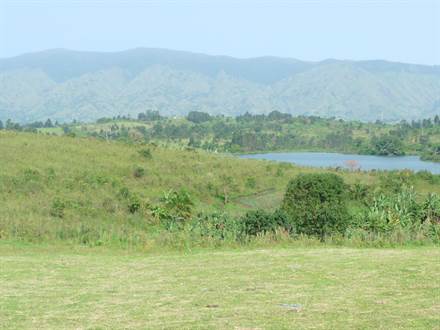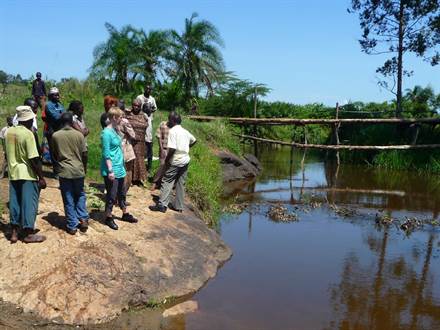
Water Supply and Sanitation (WASH) in Harmony with Nature
The grassy hillsides and vast forests around Rwambu wetland in south-western Uganda are not only a beautiful sight to see – it is fertile land which sustains agricultural based livelihoods, such as coffee, tea, bananas and beans. The Rwambu wetland is also a success story of integrated nature-based solutions.

In the not so distant past, the people of Rwambu were up against a quickly shrinking water table, largely created by agricultural expansion and bad management of the wetland. Water no longer sufficiently saturated the ground and erosion occurred all over. As a result, water supply, both for drinking and household needs, was in very short supply. Women and children were forced to walk two hours down the hillsides to the wetland in the valley to access water.
For decades, situations such as in Rwambu have been and are often still dealt with in a traditional development approach, through the installation of wells, boreholes and latrines. More often than not, such infrastructure response to water and sanitation problems is disconnected from the ecosystem it occupies, leading to poor water and waste management at the catchment level. Health, wellbeing and development of communities living in the area are regularly jeopardised, outbreaks of water-related diseases continue, and pollution of water sources and shrinking of natural resources are common occurrences.
Wetlands International advocates for working with nature-based solutions. This means bringing an understanding of the water system and the catchment to water supply, sanitation and hygiene (WASH) issues; making the links between how people use the natural system, how waste deposits in latrines end up in the natural environment and how to ensure reliable and consistent water access from wells and boreholes. All these interventions can impact community health, livelihoods and biodiversity.

In my recent visit to the Rwambu wetlands, I was inspired by what I saw – water supply and sanitation infrastructure had been developed in harmony with the landscape, optimising on Mother Nature’s natural functions.
- Uphill, stones were stacked at farmer’s fields to allow for rainwater to infiltrate the ground, in turn stopping soil erosion.
- Trees were planted at the bald spots high in the catchment, allowing further recharging of the water table.
- Downstream, former leaky latrines were replaced by functional ones and strategically relocated to avoid any contamination of present water sources.
- The wetland was demarcated and zoning was introduced, allowing community members to fetch water, feed cattle, catch fish and harvest medicinal plants and reeds at separated, best located places in the wetland.
- Farming within the wetland area was banned and affected families compensated with alternative livelihood options higher up in the catchment.
The combination of all these working with nature solutions has brought back the water table to a level where former dry points once again supply water. Specific beneficial plant and animal species have returned to the wetland and the prevalence of malaria and cholera decreased. For me, this is real evidence that a paradigm shift towards more ecological based development has taken place. It is achievable and worth investing in.
